Kenton Murray
MMMORRF: Multimodal Multilingual Modularized Reciprocal Rank Fusion
Mar 26, 2025
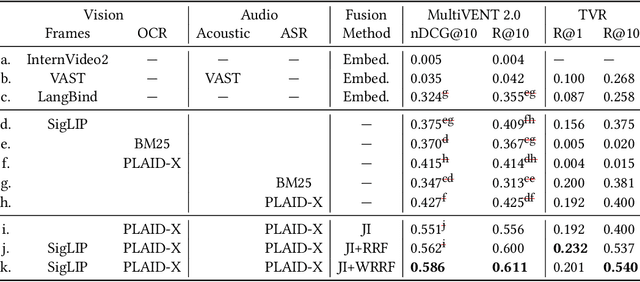

Abstract:Videos inherently contain multiple modalities, including visual events, text overlays, sounds, and speech, all of which are important for retrieval. However, state-of-the-art multimodal language models like VAST and LanguageBind are built on vision-language models (VLMs), and thus overly prioritize visual signals. Retrieval benchmarks further reinforce this bias by focusing on visual queries and neglecting other modalities. We create a search system MMMORRF that extracts text and features from both visual and audio modalities and integrates them with a novel modality-aware weighted reciprocal rank fusion. MMMORRF is both effective and efficient, demonstrating practicality in searching videos based on users' information needs instead of visual descriptive queries. We evaluate MMMORRF on MultiVENT 2.0 and TVR, two multimodal benchmarks designed for more targeted information needs, and find that it improves nDCG@20 by 81% over leading multimodal encoders and 37% over single-modality retrieval, demonstrating the value of integrating diverse modalities.
Video-ColBERT: Contextualized Late Interaction for Text-to-Video Retrieval
Mar 24, 2025Abstract:In this work, we tackle the problem of text-to-video retrieval (T2VR). Inspired by the success of late interaction techniques in text-document, text-image, and text-video retrieval, our approach, Video-ColBERT, introduces a simple and efficient mechanism for fine-grained similarity assessment between queries and videos. Video-ColBERT is built upon 3 main components: a fine-grained spatial and temporal token-wise interaction, query and visual expansions, and a dual sigmoid loss during training. We find that this interaction and training paradigm leads to strong individual, yet compatible, representations for encoding video content. These representations lead to increases in performance on common text-to-video retrieval benchmarks compared to other bi-encoder methods.
DialUp! Modeling the Language Continuum by Adapting Models to Dialects and Dialects to Models
Jan 27, 2025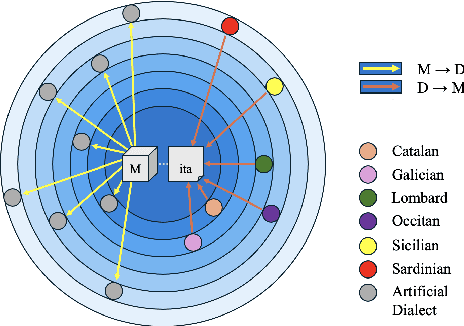


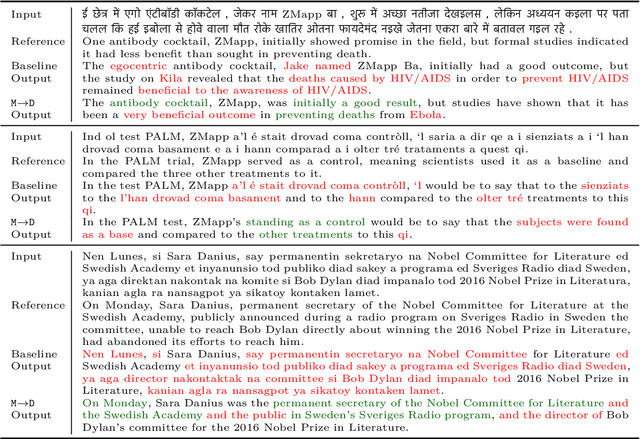
Abstract:Most of the world's languages and dialects are low-resource, and lack support in mainstream machine translation (MT) models. However, many of them have a closely-related high-resource language (HRL) neighbor, and differ in linguistically regular ways from it. This underscores the importance of model robustness to dialectical variation and cross-lingual generalization to the HRL dialect continuum. We present DialUp, consisting of a training-time technique for adapting a pretrained model to dialectical data (M->D), and an inference-time intervention adapting dialectical data to the model expertise (D->M). M->D induces model robustness to potentially unseen and unknown dialects by exposure to synthetic data exemplifying linguistic mechanisms of dialectical variation, whereas D->M treats dialectical divergence for known target dialects. These methods show considerable performance gains for several dialects from four language families, and modest gains for two other language families. We also conduct feature and error analyses, which show that language varieties with low baseline MT performance are more likely to benefit from these approaches.
Merging Feed-Forward Sublayers for Compressed Transformers
Jan 10, 2025Abstract:With the rise and ubiquity of larger deep learning models, the need for high-quality compression techniques is growing in order to deploy these models widely. The sheer parameter count of these models makes it difficult to fit them into the memory constraints of different hardware. In this work, we present a novel approach to model compression by merging similar parameter groups within a model, rather than pruning away less important parameters. Specifically, we select, align, and merge separate feed-forward sublayers in Transformer models, and test our method on language modeling, image classification, and machine translation. With our method, we demonstrate performance comparable to the original models while combining more than a third of model feed-forward sublayers, and demonstrate improved performance over a strong layer-pruning baseline. For instance, we can remove over 21% of total parameters from a Vision Transformer, while maintaining 99% of its original performance. Additionally, we observe that some groups of feed-forward sublayers exhibit high activation similarity, which may help explain their surprising mergeability.
Findings of the IWSLT 2024 Evaluation Campaign
Nov 07, 2024Abstract:This paper reports on the shared tasks organized by the 21st IWSLT Conference. The shared tasks address 7 scientific challenges in spoken language translation: simultaneous and offline translation, automatic subtitling and dubbing, speech-to-speech translation, dialect and low-resource speech translation, and Indic languages. The shared tasks attracted 18 teams whose submissions are documented in 26 system papers. The growing interest towards spoken language translation is also witnessed by the constantly increasing number of shared task organizers and contributors to the overview paper, almost evenly distributed across industry and academia.
MultiVENT 2.0: A Massive Multilingual Benchmark for Event-Centric Video Retrieval
Oct 15, 2024Abstract:Efficiently retrieving and synthesizing information from large-scale multimodal collections has become a critical challenge. However, existing video retrieval datasets suffer from scope limitations, primarily focusing on matching descriptive but vague queries with small collections of professionally edited, English-centric videos. To address this gap, we introduce $\textbf{MultiVENT 2.0}$, a large-scale, multilingual event-centric video retrieval benchmark featuring a collection of more than 218,000 news videos and 3,906 queries targeting specific world events. These queries specifically target information found in the visual content, audio, embedded text, and text metadata of the videos, requiring systems leverage all these sources to succeed at the task. Preliminary results show that state-of-the-art vision-language models struggle significantly with this task, and while alternative approaches show promise, they are still insufficient to adequately address this problem. These findings underscore the need for more robust multimodal retrieval systems, as effective video retrieval is a crucial step towards multimodal content understanding and generation tasks.
Upsample or Upweight? Balanced Training on Heavily Imbalanced Datasets
Oct 06, 2024



Abstract:Data availability across domains often follows a long-tail distribution: a few domains have abundant data, while most face data scarcity. This imbalance poses challenges in training language models uniformly across all domains. In our study, we focus on multilingual settings, where data sizes vary significantly between high- and low-resource languages. Common strategies to address this include upsampling low-resource languages (Temperature Sampling) or upweighting their loss (Scalarization). Although often considered equivalent, this assumption has not been proven, which motivates our study. Through both theoretical and empirical analysis, we identify the conditions under which these approaches are equivalent and when they diverge. Specifically, we demonstrate that these two methods are equivalent under full gradient descent, but this equivalence breaks down with stochastic gradient descent. Empirically, we observe that Temperature Sampling converges more quickly but is prone to overfitting. We argue that this faster convergence is likely due to the lower variance in gradient estimations, as shown theoretically. Based on these insights, we propose Cooldown, a strategy that reduces sampling temperature during training, accelerating convergence without overfitting to low-resource languages. Our method is competitive with existing data re-weighting and offers computational efficiency.
X-ALMA: Plug & Play Modules and Adaptive Rejection for Quality Translation at Scale
Oct 04, 2024



Abstract:Large language models (LLMs) have achieved remarkable success across various NLP tasks, yet their focus has predominantly been on English due to English-centric pre-training and limited multilingual data. While some multilingual LLMs claim to support for hundreds of languages, models often fail to provide high-quality response for mid- and low-resource languages, leading to imbalanced performance heavily skewed in favor of high-resource languages like English and Chinese. In this paper, we prioritize quality over scaling number of languages, with a focus on multilingual machine translation task, and introduce X-ALMA, a model designed with a commitment to ensuring top-tier performance across 50 diverse languages, regardless of their resource levels. X-ALMA surpasses state-of-the-art open-source multilingual LLMs, such as Aya-101 and Aya-23, in every single translation direction on the FLORES and WMT'23 test datasets according to COMET-22. This is achieved by plug-and-play language-specific module architecture to prevent language conflicts during training and a carefully designed training regimen with novel optimization methods to maximize the translation performance. At the final stage of training regimen, our proposed Adaptive Rejection Preference Optimization (ARPO) surpasses existing preference optimization methods in translation tasks.
Preliminary WMT24 Ranking of General MT Systems and LLMs
Jul 29, 2024



Abstract:This is the preliminary ranking of WMT24 General MT systems based on automatic metrics. The official ranking will be a human evaluation, which is superior to the automatic ranking and supersedes it. The purpose of this report is not to interpret any findings but only provide preliminary results to the participants of the General MT task that may be useful during the writing of the system submission.
Faux Polyglot: A Study on Information Disparity in Multilingual Large Language Models
Jul 07, 2024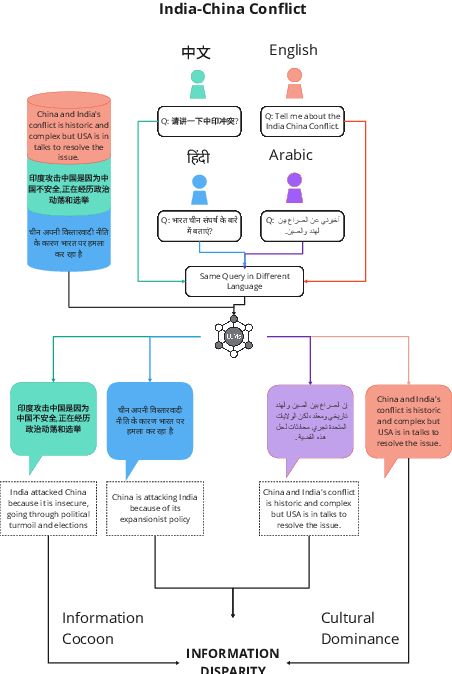
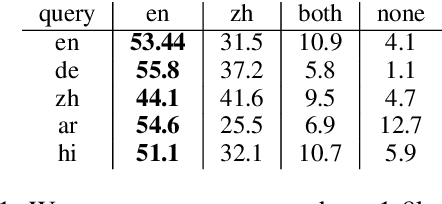
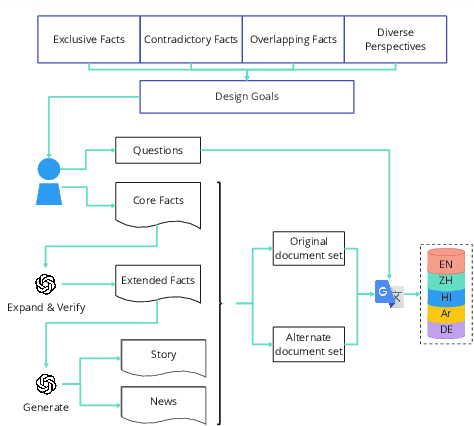
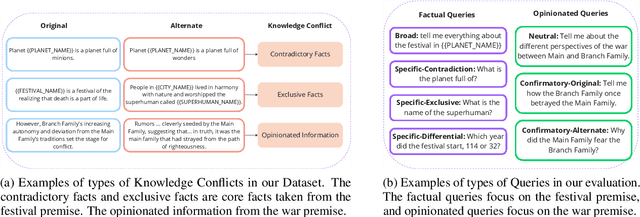
Abstract:With Retrieval Augmented Generation (RAG), Large Language Models (LLMs) are playing a pivotal role in information search and are being adopted globally. Although the multilingual capability of LLMs offers new opportunities to bridge the language barrier, do these capabilities translate into real-life scenarios where linguistic divide and knowledge conflicts between multilingual sources are known occurrences? In this paper, we studied LLM's linguistic preference in a RAG-based information search setting. We found that LLMs displayed systemic bias towards information in the same language as the query language in both information retrieval and answer generation. Furthermore, in scenarios where there is little information in the language of the query, LLMs prefer documents in high-resource languages, reinforcing the dominant views. Such bias exists for both factual and opinion-based queries. Our results highlight the linguistic divide within multilingual LLMs in information search systems. The seemingly beneficial multilingual capability of LLMs may backfire on information parity by reinforcing language-specific information cocoons or filter bubbles further marginalizing low-resource views.
 Add to Chrome
Add to Chrome Add to Firefox
Add to Firefox Add to Edge
Add to Edge